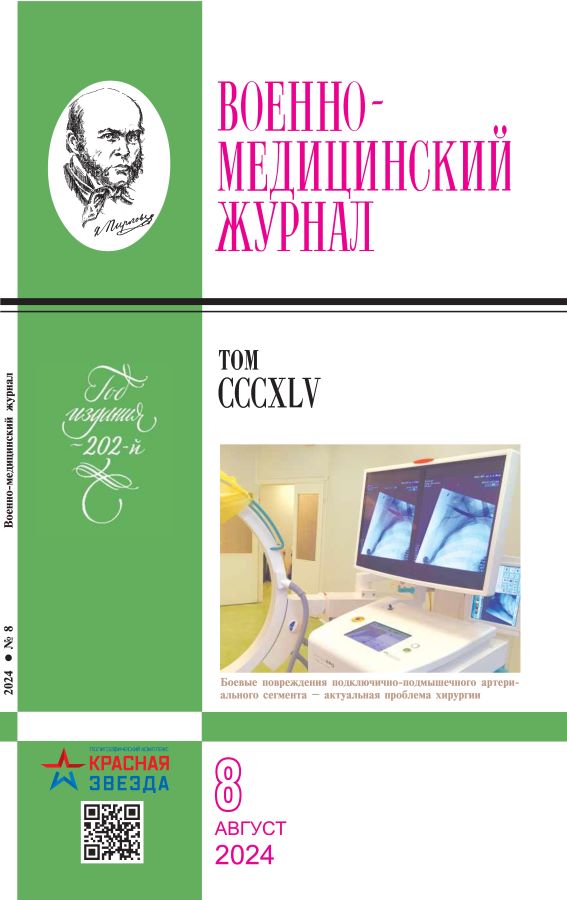Причины гибели военнослужащих в современной войне
- Авторы: Касимов Р.Р.1, Самохвалов И.М.2, Завражнов А.А.2, Кудряшов В.В.3, Коваленко С.А.1, Толмачев И.А.2
-
Учреждения:
- ФГКУ «442 Военный клинический госпиталь» МО РФ
- ФГБВОУ ВО «Военно-медицинская академия имени С.М.Кирова» МО РФ
- Военно-медицинское управление Московского военного округа МО РФ
- Выпуск: Том 345, № 8 (2024)
- Страницы: 11-16
- Раздел: Организация медицинского обеспечения Вооруженных Сил
- URL: https://journals.eco-vector.com/0026-9050/article/view/636068
- DOI: https://doi.org/10.52424/00269050_2024_345_8_11
- ID: 636068
Цитировать
Аннотация
Проанализированы причины гибели на поле боя 608 военнослужащих в холодное время года. Анализ проводился ретроспективно, по донесениям, представляемым в медицинскую службу соединений. По условиям сбора материала исследование не включало изучение наличия/отсутствия на убитых средств индивидуальной защиты, возможностей оказания первой и доврачебной помощи и своевременности эвакуации. Основной причиной гибели военнослужащих на поле боя явились тяжелые сочетанные ранения и комбинированные поражения – 38,2%. У 18,8% погибших предварительную причину гибели установить не удалось. На третьем месте среди причин гибели были тяжелые огнестрельные проникающие ранения головы (14,1%). В структуре смертельных сочетанных ранений наибольшую долю среди повреждений анатомических областей занимали конечности (78%). На втором месте – ранения груди (58,2%), на третьем – ранения головы (53%). Вследствие применения противником высокотехнологичных средств огневого поражения имеются объективные затруднения в проведении лечебно-эвакуационных мероприятий на линии боевого соприкосновения, что повышает значение раннего оказания первой помощи в порядке само- и взаимопомощи.
Полный текст
Об авторах
Р. Р. Касимов
ФГКУ «442 Военный клинический госпиталь» МО РФ
Автор, ответственный за переписку.
Email: 442vkg_med@mil.ru
кандидат медицинских наук, полковник медицинской службы
Россия, Санкт-ПетербургИ. М. Самохвалов
ФГБВОУ ВО «Военно-медицинская академия имени С.М.Кирова» МО РФ
Email: 442vkg_med@mil.ru
заслуженный врач РФ, профессор, полковник медицинской службы в отставке
Россия, Санкт-ПетербургА. А. Завражнов
ФГБВОУ ВО «Военно-медицинская академия имени С.М.Кирова» МО РФ
Email: 442vkg_med@mil.ru
профессор, полковник медицинской службы запаса
Россия, Санкт-ПетербургВ. В. Кудряшов
Военно-медицинское управление Московского военного округа МО РФ
Email: 442vkg_med@mil.ru
подполковник медицинской службы
Россия, МоскваС. А. Коваленко
ФГКУ «442 Военный клинический госпиталь» МО РФ
Email: 442vkg_med@mil.ru
полковник медицинской службы
Россия, Санкт-ПетербургИ. А. Толмачев
ФГБВОУ ВО «Военно-медицинская академия имени С.М.Кирова» МО РФ
Email: 442vkg_med@mil.ru
профессор, полковник медицинской службы запаса
Россия, Санкт-ПетербургСписок литературы
- Военно-полевая хирургия. Национальное руководство / Под ред. И.М.Самохвалова. – 2-е изд., перер. и доп. – М.: ГЭОТАР-Медиа, 2024. – 1048 с.
- Крайнюков П.Е., Самохвалов И.М., Рева В.А. Тактическая медицина – новая концепция для войн «нового типа» // Воен.-мед. журн. – 2021. – Т. 342, № 5. – С. 4–17.
- Рева В.А., Гришин М.С., Головко К.П., Денисов А.В., Меджидова А.Р. и др. Концепция применения средств временного внутриполостного гемостаза на передовых этапах оказания медицинской помощи (обзор литературы) // Воен.-мед. журн. – 2023. – Т. 344, № 1. – С. 45–54.
- Самохвалов И.М., Крюков Е.В., Маркевич В.Ю. и др. Десять хирургических уроков начального этапа военной операции // Воен.-мед. журн. – 2023. – Т. 344, № 4. – С. 4–10.
- Самохвалов И.М., Головко К.П., Гришин М.С. и др. Экспериментальное исследование эффективности местного гемостатического средства на основе хитозана и внешней компрессии живота для временной остановки внутрибрюшного кровотечения // Журн. Неотлож. хир. им. И.И.Джанелидзе. – 2023. – № 1. – С. 66–72.
- Самохвалов И.М., Гончаров А.В., Чирский В.С. и др. «Потенциально спасаемые» раненые – резерв снижения догоспитальной летальности при ранениях и травмах // Скорая мед. помощь. – 2019. – № 3. – С. 10–17.
- Тришкин Д.В. Медицинское обеспечение Вооруженных Сил Российской Федерации в условиях проведения специальной военной операции и частичной мобилизации: итоги деятельности и задачи на 2023 год // Воен.-мед. журн. – 2023. – Т. 344, № 1. – С. 4–24.
- Boffard K.D., Riou B., Warren B. et al. Recombinant factor VIIa as adjunctive therapy for bleeding control in severely injured trauma patients: two parallel randomized, placebo-controlled, double-blind clinical trials // J. Trauma. – 2005. – Vol. 59. – P. S8–15.
- Damian D.K., Penn-Barwell J.G., Wood P.R. et al. Died of wounds: a mortality review // J. R. Army Med. Corps. – 2016. – Vol. 162. – P. 355–360. doi: 10.1136/jramc-2015-000490
- Eastridge B.J., Hardin M., Cantrell J. et al. Died of wounds on the battlefield: causationand implications for improving combat casualty care // J. Trauma. – 2011. – Vol. 71. – P. S4–8.
- Eastridge B.J., Mabry R.L., Seguin P. et al. Death on the battlefield (2001–2011): implications for the future of combat casualty care // J. Trauma Acute Care Surg. – 2012. – Vol. 73. – P. S431–S437.
- Holcomb J.B., McMullin N.R., Pearse L. et al. Causes of Death in U.S. Special Operations Forces in the Global War on Terrorism 2001–2004 // Ann. Surg. – 2007. – Vol. 245. – P. 986–991.
- Kotwal R.S., Montgomery H.R., Kotwal B.M. Eliminating Preventable Death on the Battlefield // Arch. Surg. – 2011. – Vol. 146, N 12. – P. 1350–1358.
- Martin M., Oh J., Currier H. et al. An analysis of in-hospital deaths at a modern combat support hospital // J. Trauma. – 2009. – Vol. 66. – P. S51–60.
- McMullin N.R., Kauvar D.S., Currier H.M. et al. The clinical and laboratory response to recombinant factor VIIa in trauma and surgical patients with acquired coagulopathy // Curr. Surg. – 2006. – Vol. 63. – P. 246–251.
Дополнительные файлы







